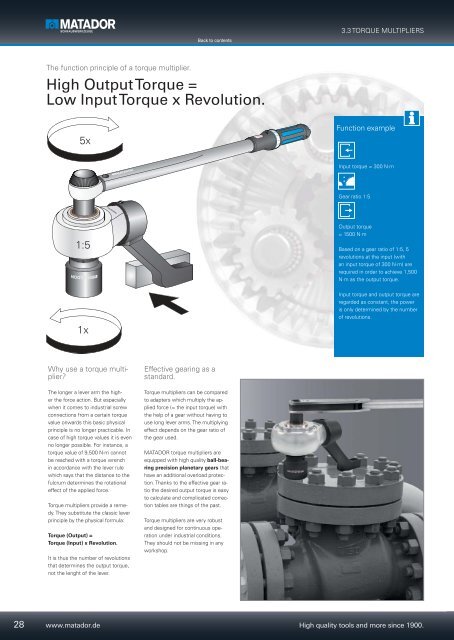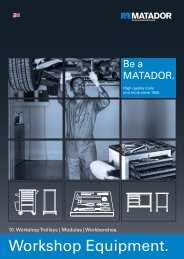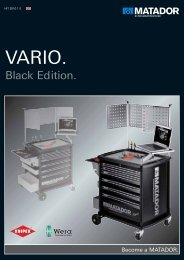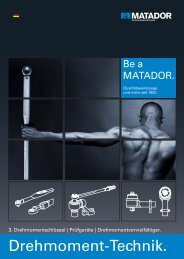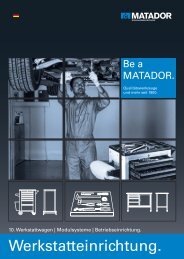Torque Control. - Matador
Torque Control. - Matador
Torque Control. - Matador
You also want an ePaper? Increase the reach of your titles
YUMPU automatically turns print PDFs into web optimized ePapers that Google loves.
The function principle of a torque multiplier.<br />
High Output <strong>Torque</strong> =<br />
Low Input <strong>Torque</strong> x Revolution.<br />
5x<br />
1:5<br />
1x<br />
Why use a torque multiplier?<br />
The longer a lever arm the higher<br />
the force action. But espacially<br />
when it comes to industrial screw<br />
connections from a certain torque<br />
value onwards this basic physical<br />
principle is no longer practicable. In<br />
case of high torque values it is even<br />
no longer possible. For instance, a<br />
torque value of 9,500 Nm cannot<br />
be reached with a torque wrench<br />
in accordance with the lever rule<br />
which says that the distance to the<br />
fulcrum determines the rotational<br />
effect of the applied force.<br />
<strong>Torque</strong> multipliers provide a remedy.<br />
They substitute the classic lever<br />
principle by the physical formula:<br />
<strong>Torque</strong> (Output) =<br />
<strong>Torque</strong> (Input) x Revolution.<br />
It is thus the number of revolutions<br />
that determines the output torque,<br />
not the lenght of the lever.<br />
Effective gearing as a<br />
standard.<br />
<strong>Torque</strong> multipliers can be compared<br />
to adapters which multiply the applied<br />
force (= the input torque) with<br />
the help of a gear without having to<br />
use long lever arms. The multiplying<br />
effect depends on the gear ratio of<br />
the gear used.<br />
MATADOR torque multipliers are<br />
equipped with high quality ball-bearing<br />
precision planetary gears that<br />
have an additional overload protection.<br />
Thanks to the effective gear ratio<br />
the desired output torque is easy<br />
to calculate and complicated correction<br />
tables are things of the past.<br />
<strong>Torque</strong> multipliers are very robust<br />
and designed for continuous operation<br />
under industrial conditions.<br />
They should not be missing in any<br />
workshop.<br />
3.3 TORQUE MULTIPLIERS<br />
Function example<br />
Input torque = 300 N·m<br />
Gear ratio 1:5<br />
Output torque<br />
= 1500 N·m<br />
Based on a gear ratio of 1:5, 5<br />
revolutions at the input (with<br />
an input torque of 300 N·m) are<br />
required in order to achieve 1,500<br />
N·m as the output torque.<br />
Input torque and output torque are<br />
regarded as constant, the power<br />
is only determined by the number<br />
of revolutions.<br />
28 www.matador.de<br />
High quality tools and more since 1900.


